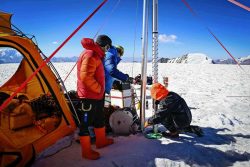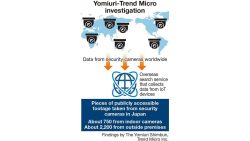
16:43 JST, January 17, 2022
The Japan Meteorological Agency did not issue tsunami warnings until 11 hours after the volcanic eruption in Tonga, due to tide level changes that differed from what Japan is used to seeing with tsunami caused by an earthquake.
The tide level changes likely occurred as a result of a different mechanism, with experts pointing to shock waves caused by the underwater eruption as one possible reason for the unusual tidal shifts.
Sudden turn at midnight
“The tide level changes were different from those seen with tsunami caused by an earthquake. We couldn’t predict how things would proceed,” Kazuki Miyaoka, the agency’s senior coordinator for seismological information, said at a press conference early Sunday.
The underwater volcano in the South Pacific island nation erupted at around 1 p.m. Saturday. A little after 7 p.m., the agency announced that there was “a possibility of slight sea level changes along the Pacific coast,” but said there was no threat of tsunami.
Around midnight, however, the situation suddenly changed. At about 11:55 p.m., a 1.2-meter-rise in the tide level was observed in Amami, Kagoshima Prefecture, prompting the agency to issue tsunami warnings and advisories to areas along the Pacific coast early Sunday.
Due to the timing, there was some confusion in those areas as residents tried to evacuate to safe locations.
From around 8 p.m. Saturday, tide level changes of a few dozen centimeters were observed near Chichijima island of the Ogasawara Islands, but this was 2½ hours earlier than the predicted time for tsunami.
Changes were also seen in other observation spots, but the agency concluded that these shifts were unrelated to tsunami caused by the eruption and opted not to make any announcement.
Although the mechanism for the latest tsunami is still being studied, the agency lifted all warnings and advisories on Sunday afternoon. Fluctuations of the ocean surface had become smaller, so it was unlikely that major changes would occur, the agency said.
“The current tsunami warning system does not include a measure for sending information on unusual tide level changes like those we just saw,” said Shinya Tsukada, director of the agency’s Earthquake and Tsunami Observation Division. “We’ll consider how we can better inform the public.”
Tohoku University Prof. Fumihiko Imamura has said the eruption triggered shock waves in the air, which he believes caused tsunami that reached coastal areas earlier.
Semicentennial eruption
The Tongan volcano that erupted is called Hunga Tonga-Hunga Ha’apai, and is located in a volcanic belt near the boundary of multiple tectonic plates covering the Earth’s surface. An eruption was detected there in 2014, and multiple eruptions have also occurred since the end of last year.
The latest massive blast was a plinian eruption, which spews out a large amount of volcanic debris. According to satellite images and other data, the plume measured 16 kilometers in height and had a radius of 250 to 400 kilometers.
On the nine-tiered Volcanic Explosivity Index, a numeric scale that measures the relative explosiveness of eruptions, the latest eruption may have been a VEI-5, the fourth highest level and considered very large, according to Prof. Hiroshi Aoyama of Hokkaido University, who specializes in physical volcanology.
Aoyama said it could have been a massive eruption that happens about once every 50 years around the world, and larger than last year’s eruption of the Fukutoku Okanoba underwater volcano near the Ogasawara Islands.
The Fukutoku Okanoba eruption was a VEI-4 — the fifth highest level — and sent a large amount of pumice drifting to Okinawa Prefecture and other areas.
Like Tonga, the Japanese archipelago is located in the volcanic belt near the border of tectonic plates. As a result of a massive underwater volcanic eruption that happened off Kagoshima Prefecture about 7,300 years ago, tsunami of seven to four meters in height are estimated to have reached the Shikoku and Kinki regions.
“There are various types of tsunami triggered by volcanoes in the ocean, making it difficult to make predictions,” said Toshitsugu Fujii, a professor emeritus at the University of Tokyo. “It is important for people to pay close attention to warnings and other information after an eruption.”
"Science & Nature" POPULAR ARTICLE
-

Genome Study Reveals Milestone in History of Cat Domestication
-

Big Leap in Quest to Get to Bottom of Climate Ice Mystery
-

Security Camera Footage Vulnerable to Outside Access; Investigation Finds 3,000 Pieces Exposed Online
-

Paws on Parade: Nairobi’s Dogs Dazzle at ‘Pawchella’
-

Japanese Eels Escape New Regulation in Vote at CITES Meeting, Avoiding Higher Prices for Dealers and Diners
JN ACCESS RANKING
-

Keidanren Chairman Yoshinobu Tsutsui Visits Kashiwazaki-Kariwa Nuclear Power Plant; Inspects New Emergency Safety System
-

Imports of Rare Earths from China Facing Delays, May Be Caused by Deterioration of Japan-China Relations
-

University of Tokyo Professor Discusses Japanese Economic Security in Interview Ahead of Forum
-

Japan Pulls out of Vietnam Nuclear Project, Complicating Hanoi’s Power Plans
-

Govt Aims to Expand NISA Program Lineup, Abolish Age Restriction
























